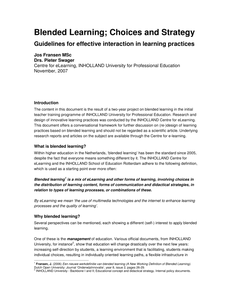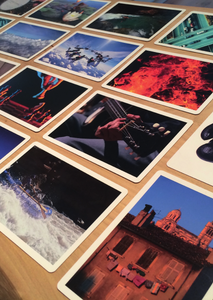Dit paper is het eindproduct van leerarrangement 1 (Zin in Leren) van de HBO masteropleiding Leren en Innoveren. Het is een literatuurstudie naar blended learning en hoe blended learning kan bijdragen aan een beter leerresultaat van de student.
DOCUMENT

The content in this document is the result of a two-year project on blended learning in the initial teacher training programme of INHOLLAND University for Professional Education. Research and design of innovative learning practices was conducted by the INHOLLAND Centre for eLearning. This document offers a conversational framework for further discussion on (re-)design of learning practices based on blended learning and should not be regarded as a scientific article. Underlying research reports and articles on the subject are available through the Centre for e-learning.
DOCUMENT

The main objective of this dissertation is to examine, both theoretically and empirically, the specific requirements of a blended learning instructional model aimed at facilitating higher education adult-learners into online interaction. Three objectives were formulated: Objective 1: to investigate adult-learners’ perceived satisfaction in relation to blended learning and the factors that foster their interaction with the ‘added’ online mode; and a thorough understanding of adult-learners’ educational needs and learning characteristics derived from theory. Objective 2: to understand the factors of social presence and convergence, and how these can be ingrained into design principles that foster online interaction. Objective 3: to explore the specifics of an instructional model for the design of a blended learning environment for adult-learners in higher education, both theoretically and empirically, and how said principles can be actualised in a validated model.
DOCUMENT

Blended learning is not a flash in the pan, it’s here to stay. At The Hague University of Applied Sciences (THUAS) the implementation of blended learning is not yet in an adult stage, but in a newly introduced educational framework (The Hague University of Applied Sciences, 2017) blended learning plays a vital role. The intention is for teams to come to a shared approach when it comes to blended learning. In his blog, Leonard Geluk, (Geluk, 2016) the Chairman of the Executive Board of the University notes that ‘the development is slow to get off the ground’ and ‘there is still work to be done before we can fully embed ICT in education.’ The toolkit of teachers has been supplemented with many digital tools in recent decades (Geluk, 2014), but what makes lecturers actually use these new possibilities? What causes them to pick up the toolkit or leave it? Jacobs (2013) indicates that people’s ability to exploit the benefits of technology, in particular digital technology, is not obvious and can be a big challenge, especially for teachers. The central question to this study is: What brings lecturers in motion around blended learning? In my opinion, gaining more understanding in the lecturers’ perspective is an important part of the ‘work’ that Leonard Geluk describes above. This is the main goal of this research.
DOCUMENT

Presented at the Essence International Conference, Alcoi – Sept 22 2015. The link refers to a youtube video recording of the presentation. This presentation describes a project for online and blended learning.
MULTIFILE

From the article: "This paper describes the process of introducing blended learning in a CS educational program. The methodology that has been used as well as the motivation for the choices made are given. The rst results compared with results from previous courses that used a more classical teaching approach are given. These results show that the new methodology proves to be promising and successful. The successes of the new program as well as the problems encountered are discussed with their possible solution."
MULTIFILE

Within NHL Stenden University of Applied Science, a choice for a new virtual learning environment was made in mid-2021, primarily on policy and management grounds. Early in the migration process, it became clear that this approach could perturb the further rollout of the Design-Based Education (DBE, https://edu.nl/mwp8j) educational concept. Four templates were developed to intertwine technological and educational processes that structure different ways of "blended" learning and teaching within DBE. Initial user experiences show that the templates’ structures help teachers reconsider online learning activities to shape and facilitate blended DBE learning processes.
DOCUMENT

Contemporary education increasingly involves a blended learning environment, which consists of a combination of offline and online delivery methods. Blended learning environments can motivate students to learn, but designing motivating blended learning environments is challenging and can result in environments that demotivate students. This conceptual article proposes a blended learning design that helps practitioners to design motivating blended learning environments. According to self-determination theory, students are motivated to learn when their three basic psychological needs for autonomy, competence, and relatedness are supported. Competency-based education (CBE) is intended to support students’ basic psychological needs. We have constructed design guidance for CBE programmes that help practitioners to design a combination of offline and online delivery methods that (1) give students choices in time and place to support their need for autonomy, (2) adapt to students’ competency levels to support their need for competence, and (3) stimulate students’ relationship building with peers and teachers to support their need for relatedness. Although the design guidance is tentative, practitioners can experiment with it to design blended learning environments that motivate students to learn.
DOCUMENT

Although self-regulation is an important feature related to students’ study success as reflected in higher grades and less academic course delay, little is known about the role of self- regulation in blended learning environments in higher education. For this review, we analysed 21 studies in which self-regulation strategies were taught in the context of blended learning. Based on an analysis of literature, we identified four types of strategies: cognitive, metacognitive, motivational and management. Results show that most studies focused on metacognitive strategies, followed by cognitive strategies, whereas little to no attention is paid to motivation and management strategies. To facilitate self-regulation strategies non-human student tool interactional methods were most commonly used, followed by a mix of human student-teacher and non-human student content and student environment methods. Results further show that the extent to which students actively apply self-regulation strategies also depends heavily on teacher's actions within the blended learning environment. Measurement of self-regulation strategies is mainly done with questionnaires such as the Motivation and Self-regulation of Learning Questionnaire.Implications for practice and policy:•More attention to self-regulation in online and blended learning is essential.•Lecturers and course designers of blended learning environments should be aware that four types of self-regulation strategies are important: cognitive, metacognitive, motivational and management.•Within blended learning environments, more attention should be paid to cognitive, motivation and management strategies to promote self-regulation.
DOCUMENT

Blended learning, a teaching format in which face-to-face and online learning is integrated, nowadays is an important development in education. Little is known, however, about its affordances for teacher education, and for domain specific didactical courses in particular. To investigate this topic, we carried out a design research project in which teacher educators engaged in a co-design process of developing and field-testing open online learning units for mathematics and science didactics. The preliminary results concern descriptions of the work processes by the design teams, of design heuristics, and of typical ways of collaborating. These findings are illustrated for the case of two of the designed online units on statistics didactics and mathematical thinking, respectively.
LINK